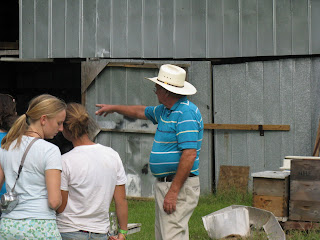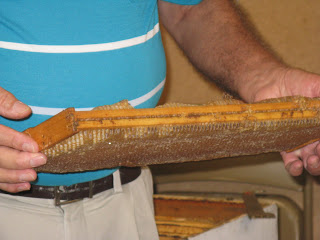In his “In Defense of Food”, Michael Pollen posits, “most of what we’re consuming today is no longer, strictly speaking, food at all” (7). American culture has an eating disorder. Not only have obesity and chronic heart become epidemics in the past decade, but we consciously compromise food for synthetic nutrients, health for mass distribution, land for mass production, and community for a quick bite that often leaves us feeling unsatisfied. Worst of all, most of us cannot talk about where our food comes from. But as a nation struggling with eating, a movement is on the rise. Consumers want chemical-free produce. They want to know where their food was produced and if other were exploited in the process. They want real, ethical, healthy food. And as a University on the forefront of education and a beacon for the common good, we have an inherent responsibility to address these concerns in the context of the classroom. We should be teaching more students about what they are eating, raising awareness about devastating industrial agricultural practices, and asking critical environmental and ethical questions about food production. While we have taken some necessary steps in this direction, bringing an organic garden on campus is essential to meeting these demands and making the University a global leader in agricultural sustainability.
An increasingly popular attitude of consumers in response to the rising anxiety towards mass food production and chemical treatment is “Eat Local. Eat Organic”. As a result, many Universities have started organic gardens to provide a classroom that creates a direct relationship between students and farming, including the University of New Hampshire, Harvard, Stony Brook University, Furman University, and the University of Florida. Not only do students learn about and participate in agricultural practices, but some of these colleges, such as Furman, incorporate the food into campus dining halls, thereby allowing students to experience the beauty of eating locally grown, organic food. Additionally, professors use these gardens as a research sites. According to the Furman’s organic garden mission statement, “People are hungry for not just for fresh, healthy and fair food, but for knowledge and experience of participating in solutions.”
Students and faculty at our University hunger for this knowledge, experience, and available organic food as well. In the fall of 2008, several students established the UA Organic Community Garden Initiative to establish such a garden on campus with the desire to bring more local food into the dining halls and educate students about organic agriculture. Though they obtained support from multiple campus facets and even obtained funding for a water connection, the University denied the project because of aesthetic and managerial concerns. Yet, hope and passion for the initiative remained. Students subsequently started an on-campus garden at the University’s arboretum as a pilot project and compromise. Having been very involved in this effort for the past year, I have witnessed over fifty students work in the garden and discover the inherent joy that resides in harvesting food that one has planted and nurtured. I have also seen how this experiential learning inspires and engages students. Moreover, I have realized within this last semester that this setup can only be a temporary solution to a dire campus need and am forced to ask: If other Universities have successfully established gardens on their campuses, gardens that provide food for the campus, educational spaces, and academic opportunities, why can’t we overcome our issues and take advantage of such a valuable and easy endeavor?
This past fall I performed an independent study on organic gardening to fulfill a New College requirement. While I had had experience working on the garden, I did not fully comprehend the implications of the initiative until I started applying classroom concepts to our actions at the student garden. One of these concepts is soil health. As all farmers and gardeners know, soil health is necessary for abundant crop production. However, what many do not recognize is that creating and maintaining a good soil is a holistic process, one that considers how texture, structure, richness of certain nutrients, and presence of beneficial microorganisms collectively influence the soil. When fertilizers and pesticides are applied, two practices that are popular in industrial agriculture, they oftentimes kill the beneficial microorganisms that decompose organic material into the nutrients that feed plants, and the subsequent deficiency of these microorganisms can last for years in affected soils. This is why organic and holistically-minded methods such as crop rotation are much better solutions for agricultural problems. Rather than trying to identify and fix a single issue, their consequences acknowledge the natural balances that are crucial to food production and provide long-term solutions. According to author Wendell Berry, “A good solution improves the balances, symmetries, or harmonies within a pattern –it is a qualitative solution – rather than enlarging or complicating some part of a pattern at the expense or in neglect of the rest.” (272). Hence, we need to have a garden on campus so that students can apply these solutions, witness the results, and understand the value of approaching any issue from a holistic perspective.
Another reason that the University needs to allow the garden to greet campus soil is because of the arboretum’s distance campus. While only fifteen minutes away, having one or two students drive out there daily to perform necessary maintenance is unsustainable, and biking to the arboretum is practically infeasible–especially on days when students must return to campus and go to class. Many students voiced concern this semester about not having the time to travel to and from the arboretum as a reason for not fully committing to the project. Having the garden at the arboretum also creates difficulties for newcomers, who are usually unfamiliar with the arboretum and do not feel comfortable with going out there alone. If the University is genuinely passionate about using the garden as a teaching tool and educating the most students possible about agricultural issues, it will have to move the garden on campus.
When I started working on the garden initiative, I knew little about industrial agriculture and organic farming, and my main concern was creating another beautiful place of leisure on campus. I continue to believe that having an on-campus garden will make great aesthetic and social contributions to the University. But my work on the student garden and my classroom learning have taught me priceless lessons about agricultural practices, such as how the implementation of organic methods is crucial to the health of our environment and the survival of our species. Our University is currently behind in becoming a true environmental steward. This can and will change, though, when we fully recognize the benefits of projects like an on-campus garden and commit our time, energy, and resources in order to realize such initiatives. And if we are as concerned about being leaders of change and social responsibility as we advertise, then we must turn our promises into actions.


































 It's been raining for almost a week straight, and the consequences are evident. The tomato plants received the most damage: one whole plant topped over, while all of the ripe tomatoes burst from an abundance of water.
It's been raining for almost a week straight, and the consequences are evident. The tomato plants received the most damage: one whole plant topped over, while all of the ripe tomatoes burst from an abundance of water.















